

Taking a sponge bath in the bathroom sink and going to a tanning bed are just some of the productivity killers American employers have observed.
When asked to name the biggest productivity killers for a 2015 CareerBuilder survey, employers cited the following:
Read: Top 12 excuses workers have used for being late
1. Cell phones/texting: 52%
2. The Internet: 44%
3. Gossip: 37%
4. Social media: 36%
5. Email: 31%
6. Co-workers dropping by: 27%
7. Meetings: 26%
8. Smoke breaks/snack breaks: 27%
9. Noisy co-workers: 17%
10. Sitting in a cubicle: 10%
Read: Top 12 excuses workers have used for being late
The weirdest productivity killers
Employers were also asked to reveal the most unusual things they’ve seen employees do to avoid work. Some answers included:
• Employee was taking a sponge bath in the bathroom sink.
• Employee was trying to hypnotize other employees to stop their smoking habits.
• Employee was visiting a tanning bed in lieu of making deliveries.
• Employee was drinking vodka while watching Netflix.
• Employee was sleeping on the CEO’s couch.
• Employee was sending inappropriate pictures to other employees.
• Employee was searching Google images for “cute kittens.”
• Employee was making a model plane.
• Employee was printing pictures of animals, naming them after employees and hanging them in the work area.
• Employee was sabotaging another employee’s car tires.
Read: Top 10 strange reasons for calling in sick
The consequences of distraction
The survey shows productivity killers hurt employers in a number of ways, including compromised work quality, lower morale because other employees need to pick up the slack, a more strained boss/employee relationship, missed deadlines and revenue loss.
What employers can do
About 75% of employers that participated in the survey have taken at least one step to limit productivity distractions, such as blocking certain Internet sites (33%) and banning personal calls/cell phone use (23%).
Other efforts include scheduling lunch and break times (21%), monitoring emails and Internet use (21%), limiting meetings (16%), allowing telecommuting (13%) and having an open space layout instead of cubicles (12%).
